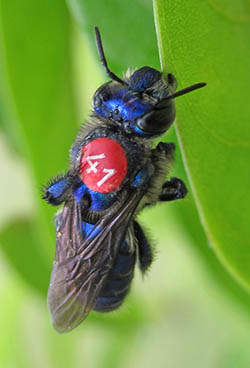All the Single Ladies

When you think about a bee, it’s probably a bright yellow and black striped honey bee or bumblebee. These bees live in big colonies that are almost all females--usually a mother who is called a queen and her many, many daughters who are called workers.
Honey bees have very advanced social lives. The females in a colony cooperate to help the colony grow and survive. Different bees have different jobs. The queen is in charge of laying eggs, producing new workers to help the colony grow. The workers don’t lay eggs, but they do all of the other jobs needed to keep the colony going. Workers feed the queen and the “brood” the young, growing bees. Workers also build the nest and collect all of the food to feed the entire colony. They defend the colony from potential enemies. Without all of these bees doing their different jobs, a honey bee colony can’t succeed.
It might surprise you to hear that most bees look very and live very differently from honey bees. There are about 4000 different bee species in North America, and most of them don’t live in colonies. Most bees live alone. Each female bee makes her own nest and raises her own offspring without help from her sisters or daughters. These “solitary” bees have to do all of the different jobs that the queen and honey bee workers share.
Like most bees, orchid bees don’t live in large colonies. Some orchid bees live alone and others live in small groups. Most orchid bees that live in groups still live more or less like solitary bees. These bees still do all of the jobs themselves: they work on the nest, collect food, and lay eggs. One job that these bees do share is protecting the nest. Bees need to leave the nest to collect food for themselves and their brood. When the adult bees are gone, the brood is undefended from fierce predators like ants and wasps. But when many females live together, there is almost always an adult female in the nest to protect the brood.

Better protection for the growing brood is one benefit to living in a group, Scientists are studying orchid bees to learn more about what other advantages group living bees might have, and also what disadvantages they have. Hopefully orchid bees will help us to understand why some bees live alone, some bees live together, and other bees can’t live alone!
Read more about: Bee Jeweled
Bibliographic details:
- Article: All the Single Ladies
- Author(s): Dr. Biology
- Publisher: Arizona State University School of Life Sciences Ask A Biologist
- Site name: ASU - Ask A Biologist
- Date published:
- Date accessed:
- Link: https://askabiologist.asu.edu/female-orchid-bees
APA Style
Dr. Biology. (). All the Single Ladies. ASU - Ask A Biologist. Retrieved from https://askabiologist.asu.edu/female-orchid-bees
Chicago Manual of Style
Dr. Biology. "All the Single Ladies". ASU - Ask A Biologist. . https://askabiologist.asu.edu/female-orchid-bees
Dr. Biology. "All the Single Ladies". ASU - Ask A Biologist. . ASU - Ask A Biologist, Web. https://askabiologist.asu.edu/female-orchid-bees
MLA 2017 Style

Female orchid bees can sometimes be found sleeping attached to a leaf.
Be Part of
Ask A Biologist
By volunteering, or simply sending us feedback on the site. Scientists, teachers, writers, illustrators, and translators are all important to the program. If you are interested in helping with the website we have a Volunteers page to get the process started.


